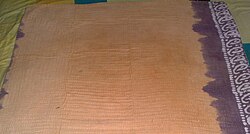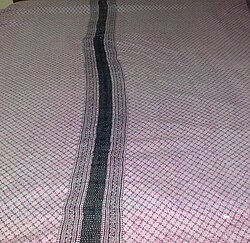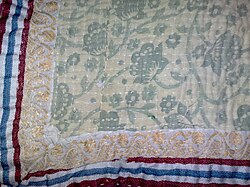
Embroidery is the art of decorating fabric or other materials using a needle to stitch thread or yarn. Embroidery may also incorporate other materials such as pearls, beads, quills, and sequins. In modern days, embroidery is usually seen on hats, clothing, blankets, and handbags. Embroidery is available in a wide variety of thread or yarn colour. It is often used to personalize gifts or clothing items.

Quilting is the process of joining a minimum of three layers of fabric together either through stitching manually using a needle and thread, or mechanically with a sewing machine or specialised longarm quilting system. An array of stitches is passed through all layers of the fabric to create a three-dimensional padded surface. The three layers are typically referred to as the top fabric or quilt top, batting or insulating material, and the backing.

Patchwork or "pieced work" is a form of needlework that involves sewing together pieces of fabric into a larger design. The larger design is usually based on repeating patterns built up with different fabric shapes. These shapes are carefully measured and cut, basic geometric shapes making them easy to piece together.

A quilt is a multi-layered textile, traditionally composed of two or more layers of fabric or fiber. Commonly three layers are used with a filler material. These layers traditionally include a woven cloth top, a layer of batting or wadding, and a woven back combined using the techniques of quilting. This is the process of sewing on the face of the fabric, and not just the edges, to combine the three layers together to reinforce the material. Stitching patterns can be a decorative element. A single piece of fabric can be used for the top of a quilt, but in many cases the top is created from smaller fabric pieces joined, or patchwork. The pattern and color of these pieces creates the design. Quilts may contain valuable historical information about their creators, "visualizing particular segments of history in tangible, textured ways".

Sashiko is a type of traditional Japanese embroidery or stitching used for the decorative and/or functional reinforcement of cloth and clothing. Owing to the relatively cheap nature of white cotton thread and the abundant nature of cheap, indigo-dyed blue cloth in historical Japan, sashiko has a distinctive appearance of white-on-blue embroidery, though some decorative pieces may also use red thread.

Appliqué is ornamental needlework in which pieces or patches of fabric in different shapes and patterns are sewn or stuck onto a larger piece to form a picture or pattern. It is commonly used as decoration, especially on garments. The technique is accomplished either by hand stitching or machine. Appliqué is commonly practised with textiles, but the term may be applied to similar techniques used on different materials. In the context of ceramics, for example, an appliqué is a separate piece of clay added to the primary work, generally for the purpose of decoration.
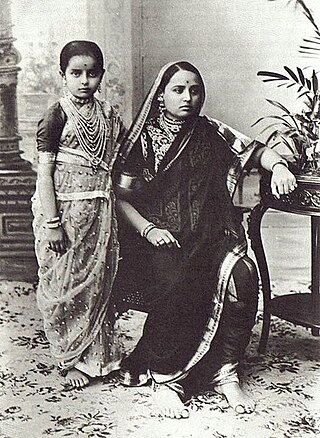
A sari is a women's garment from the Indian subcontinent. It consists of an un-stitched stretch of woven fabric arranged over the body as a robe, with one end attached to the waist, while the other end rests over one shoulder as a stole, sometimes baring a part of the midriff. It may vary from 4.1 to 8.2 metres in length, and 60 to 120 centimetres in breadth, and is a form of ethnic wear in Bangladesh, India, Sri Lanka, Nepal, and Pakistan. There are various names and styles of sari manufacture and draping, the most common being the Nivi style. The sari is worn with a fitted bodice also called a choli and a petticoat called ghagra, parkar, or ul-pavadai. It remains fashionable in the Indian subcontinent today.

A kurta is a loose collarless shirt or tunic worn in many regions of South Asia, and now also worn around the world. Tracing its roots to Central Asian nomadic tunics, or upper body garments, of the late-ancient- or early-medieval era, the kurta has evolved stylistically over the centuries, especially in South Asia, as a garment for everyday wear as well as for formal occasions.

Chikankari is a traditional embroidery style from Lucknow, India. Translated, the word means embroidery, and it is one of Lucknow's best known textile decoration styles. The main market in Lucknow for Chikankari based products is Chowk. Production is mainly based in Lucknow and in the adjoining districts.

Phulkari refers to the folk embroidery of the Punjab region and Gulkari of Sindh in South Asia.
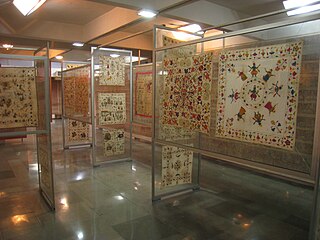
Embroidery in India includes dozens of embroidery styles that vary by region and clothing styles. Designs in Indian embroidery are formed on the basis of the texture and the design of the fabric and the stitch. The dot and the alternate dot, the circle, the square, the triangle, and permutations and combinations of these constitute the design.

Sitalpati, also called sital pati, sittal pati and adi, is a kind of mat which feels cold by nature. It is made from murta plants. It is usually used in Bangladesh. Mats with decorative designs are called nakshi pati.

Ghagra choli is a type of ethnic clothing for women from the India, notably in the Indian states of Rajasthan, Gujarat, Madhya Pradesh, Uttar Pradesh, Bihar, Haryana, Punjab, Himachal Pradesh, Uttarakhand, Jammu and Kashmir. In Punjab, the lehenga is traditionally worn with a kurti. It is a combination of the ‘’ghagra or lehenga and the choli (blouse). In contemporary and modern usage lehenga choli is the widely used term by fashion designers, trend setters, and boutiques in India, since ghagra is synonymous with the half-slip (petticoat) worn as an undergarment below the sari.
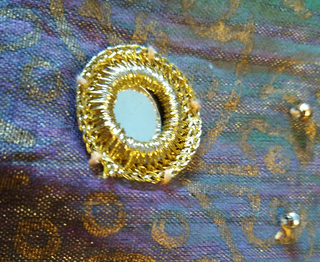
Shisheh or abhla bharat embroidery, or mirror-work, is a type of embroidery which attaches small pieces of mirrors or reflective metal to fabric. Mirror embroidery is common throughout Asia, and today can be found in the traditional embroidery of the Indian subcontinent, Afghanistan, China, and Indonesia.

Nakshi kantha, a type of embroidered quilt, is a centuries-old Bengali art tradition of the Bengal region, notably in Bangladesh and the Indian states of West Bengal, Tripura, and parts of Assam. The basic materials used are thread and old cloth. Nakshi kanthas are made throughout Bangladesh, primarily in the areas of Mymensingh, Jamalpur, Bogra, Rajshahi, Faridpur, Jessore, and Chittagong.

Handloom saris are a traditional textile art of Bangladesh and India. The production of handloom saris is important for economic development in rural India.

Embroidery was an important art in the Islamic world from the beginning of Islam until the Industrial Revolution disrupted traditional ways of life.
The Sujani embroidery work of Bihar, is a textile expressive art product, given protection under the GI registration act. It is usually a quilt or bed spread, which was earlier made of old clothes, but is now generally made of easily available fabric with embroidery done with the most simple stitches with motifs narrating stories. It is exclusively made by women in 15 villages of Bhusra in the Gaighat block of Muzaffarpur and a few villages of Madhubani in the Indian state of Bihar.
Hunan embroidery, or Xiang embroidery, as one of the traditional folk arts of China, together with Cantonese embroidery, Sichuan embroidery and Suzhou embroidery, is regarded as the four most distinguished embroidery styles in China. It is a general name for the embroidery products which rise from and are mostly produced at Changsha, Hunan, with distinct characteristics of Chu culture. Hunan embroidery is particularly famous in embroidering with silk thread, and the patterns have a high sense of reality. In 2006, Hunan embroidery was selected into the first batch of national intangible cultural heritage list.

Godadi or "Gudri" is used to refer to a quilt with a variant of the word found in several Indian languages including Hindi, Marathi, Urdu, Gujarati, Konkani, Kannada and Punjabi, and other north Indian and southern languages and dialects. It is a special kind of quilt, that can be also embroidered and is made by patching various pieces of cloth. Godadi used to be handmade by housewives from various parts of India. In some parts of India, including in Maharashtra, Gujarat and north India, bits from used clothes, sarees, dupattas would be stitched together, sometimes in beautiful patters. In Konkan, very finely embroidered and intricately patched godadis are given as a part of bride's trousseau. In eastern India, especially Orissa and Bengal they are also called as "Kantha".

